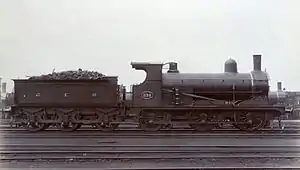GER Class N31
The GER Class N31 was a class of eighty-two 0-6-0 steam locomotives designed by James Holden for the Great Eastern Railway. Eighteen passed to the London and North Eastern Railway (LNER) at the 1923 grouping and received the LNER classification J14.
| GER Class N31 LNER Class J14 | |||||||||||||||||||||||||||||||
|---|---|---|---|---|---|---|---|---|---|---|---|---|---|---|---|---|---|---|---|---|---|---|---|---|---|---|---|---|---|---|---|
 Great Eastern Class N31 locomotive 998 | |||||||||||||||||||||||||||||||
| |||||||||||||||||||||||||||||||
| |||||||||||||||||||||||||||||||
| |||||||||||||||||||||||||||||||
| |||||||||||||||||||||||||||||||
History
These goods locomotives had 17.5-by-24-inch (444 mm × 610 mm) cylinders, 4-foot-11-inch (1.499 m) driving wheels, and a 160-pound-force-per-square-inch (1,100 kPa) boiler. Eighty-one were built at Stratford Works between 1893 and 1898.
Table of orders and numbers
| Year | Order | Quantity | GER Nos. | Notes |
|---|---|---|---|---|
| 1893 | N31 | 1 | 999 | |
| 1893 | H33 | 10 | 979–988 | |
| 1894 | L33 | 10 | 989–998 | |
| 1894 | E34 | 10 | 969–978 | |
| 1896 | N37 | 10 | 959–968 | |
| 1897 | H40 | 10 | 949–958 | |
| 1897 | O41 | 10 | 602–608, 946–948 | |
| 1898 | G42 | 10 | 542–551 | |
| 1898 | K43 | 10 | 562–571 | |
Class 127
In addition, when the Class 127 locomotive was rebuilt from compound to simple in 1895, it was then included into Class N31.[1]
Performance
They were not particularly successful locomotives. Although nicknamed Swifts, they were sluggish locomotives, due to the placement of the valve chests underneath the cylinders.[1][2]
Withdrawals
Withdrawals started in 1908, and by the end of 1922, only eighteen were left in service. The LNER allocated numbers 7000 higher than the locomotives' GER numbers, but withdrawals continued, and by 1925 the class was extinct.
| Year | Quantity in service at start of year | Quantity withdrawn | Locomotive numbers |
|---|---|---|---|
| 1908 | 82 | 1 | 971 |
| 1909 | 81 | 18 | 546, 549, 565, 566, 570, 571, 602, 605, 608, 950, 953–955, 957, 966, 969, 972, 975 |
| 1910 | 63 | 14 | 542, 550, 563, 568, 569, 603, 606, 956, 962, 974, 982, 989, 990, 991 |
| 1911 | 49 | 9 | 547, 551, 562, 567, 958, 960, 961, 988, 997 |
| 1912 | 40 | 6 | 544, 949, 952, 967, 968, 996 |
| 1913 | 34 | 3 | 607, 979, 935 (ex-127) |
| 1914 | 31 | 3 | 0545, 0564, 947 |
| 1915 | 28 | 1 | 946 |
| 1916 | 27 | 1 | 994 |
| 1920 | 26 | 2 | 0543, 999 |
| 1921 | 24 | 1 | 965 |
| 1922 | 23 | 5 | 548, 948, 986, 992, 995 |
| 1923 | 18 | 6 | 959, 970, 976, 980, 985, 993 |
| 1924 | 12 | 5 | 951, 963, 964, 977, 978 |
| 1925 | 7 | 7 | 604, 973, 981, 983, 984, 987, 998 |
References
- Aldrich 1969, p. 77
- Aldrich 1969, p. 75
- Aldrich 1969, pp. 77, 134, 138–139
External links
| Wikimedia Commons has media related to GER Class N31 / LNER Class J14. |
- N31 Class 0-6-0 1891-1898 — Great Eastern Railway Society
- The Class J14 (GER Class N31) 0-6-0 Locomotives — LNER Encyclopedia